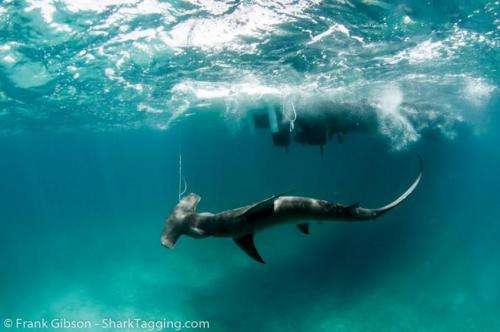New study reveals vulnerability of sharks as collateral damage in commercial fishing

A new study that examined the survival rates of 12 different shark species when captured as unintentional bycatch in commercial longline fishing operations found large differences in survival rates across the 12 species, with bigeye thresher, dusky, and scalloped hammerhead being the most vulnerable. The study, led by researchers at the University of Miami (UM) Rosenstiel School of Marine and Atmospheric Science and UM Abess Center for Ecosystem Science and Policy, provides new information to consider for future conservation measures for sharks in the Northwest Atlantic.
The unintentional capture of a fish species when targeting another species, known as bycatch, is one of the largest threats facing many marine fish populations.
Researchers from UM and the National Marine Fisheries Service analyzed over 10 years of shark bycatch data from the western Atlantic Ocean and Gulf of Mexico tuna and swordfish longline fisheries to examine how survival rates of sharks were affected by fishing duration, hook depth, sea temperature, animal size and the target fish. Some species, such as the tiger shark, exhibited over 95% survival, whereas other species survival was significantly lower, in the 20-40% range, such as night shark and scalloped hammerheads.
"Our study found that the differences in how longline fishing is actually conducted, such as the depth, duration, and time-of-day that the longlines are fished can be a major driver of shark survival, depending on the species," said UM Rosenstiel School Ph.D student and lead author Austin Gallagher. "At-vessel mortality is a crucial piece of the puzzle in terms of assessing the vulnerability of these open-ocean populations, some of which are highly threatened."
The researchers also generated overall vulnerability rankings of species taking into account not only their survival, but also reproductive potential. They found that species most at risk were those with both very slow reproductive potential and unusual body features, such as hammerheads and thresher sharks. The paper's authors suggest that bycatch likely played an important role in the decline of scalloped hammerhead species in the Northwest Atlantic, which has been considered for increased international and national protections, such as the U.S. Endangered Species List.
The researchers suggest that high at-vessel mortality, slow maturity, and specialized body structures combine for the perfect mixture to become extinction-prone.
"Our results suggest that some shark species are being fished beyond their ability to replace themselves," said UM Research Assistant Professor Neil Hammerschlag. "Certain sharks, such as big eye threshers and scalloped hammerheads, are prone to rapidly dying on the line once caught and techniques that reduce their interactions with fishing gear in the first place may be the best strategy for conserving these species."
The study, titled "Vulnerability of oceanic sharks as pelagic longline bycatch" was published online in the open-access journal Global Ecology and Conservation.
Provided by University of Miami
















